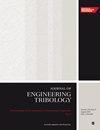航空抗磨添加剂对摩擦膜形成和微点蚀倾向的影响
IF 1.8
3区 工程技术
Q3 ENGINEERING, MECHANICAL
Proceedings of the Institution of Mechanical Engineers, Part J: Journal of Engineering Tribology
Pub Date : 2023-04-11
DOI:10.1177/13506501231167621
引用次数: 0
摘要
本文研究了抗磨添加剂对微点蚀和摩擦膜形成的影响。特别是,已经将航空应用中使用的抗磨添加剂与常用的汽车抗磨添加剂(二烷基二硫代磷酸锌(ZDDP))进行了比较,后者已知会促进微点蚀。所有测试都是在劳斯莱斯新发动机UltraFan©的动力变速箱测试条件下进行的。使用微点蚀装置进行的测试发现,ZDDP形成微坑的速度最快,然后传播到最大的磨损上,显示出微点蚀的灾难性影响。而其他航空抗磨添加剂,如磷酸三甲酯和添加剂X,形成微坑的速度比只含基础油的配方慢,但速度更快。用焦点变化显微镜对微坑进行表征,发现ZDDP形成的微坑比其他抗磨添加剂更小、更浅,因此ZDDP辊的磨损轨迹粗糙度最低。未添加的基础油虽然产生微坑的速度较慢,但会迅速传播到更严重的失效模式,显示出没有添加抗磨添加剂的有害影响。轮廓仪结果表明,ZDDP的表面环粗糙度保持最高,证实了ZDDP快速形成摩擦膜。这可以保护凹凸不平,从而促进微点蚀,因为保持了较高的局部凹凸不平接触压力。通过使用具有间隔层成像的小型牵引机评估摩擦膜,在代表性条件下形成摩擦膜,进一步证实了这一点。这表明ZDDP比航空抗添加剂形成更厚的摩擦膜,且速度更快。总的来说,研究表明,航空抗磨添加剂对微点蚀的促进作用小于ZDDP,但大于基础油。摩擦膜形成的缓慢作用允许表面的初始磨合,这减缓了微点蚀的开始。本文章由计算机程序翻译,如有差异,请以英文原文为准。
The effect of aviation anti-wear additives on tribofilm formation and micropitting propensity
This article studies the effect of anti-wear additives on micropitting and tribofilm formation. In particular, anti-wear additives used in aviation applications have been compared against a commonly used automotive anti-wear additive (zinc dialkyldithiophosphate ((ZDDP)) that is known to promote micropitting. All tests were performed under test conditions representative of the Power GearBox within Rolls-Royce's new engine, the UltraFan©. Tests using a micropitting rig found that ZDDP formed micropits the fastest, which then propagated onto the largest amount of wear showing the catastrophic effects of micropitting. Whereas other aviation anti-wear additives, such as tricresyl phosphate and additive X, formed micropits more slowly but faster than the formulation without additives containing only base oil. Focus variation microscopy was used to characterise the micropits and found that ZDDP formed smaller and shallower micropits than the other anti-wear additives, and as a result, the wear track of the ZDDP roller had the lowest roughness. The unadditised base oil, whilst it generated micropits more slowly, propagated quickly to a more severe failure mode, showing the harmful effects of having no anti-wear additive present. The profilometer results showed the counterface ring roughness for ZDDP remained the highest, confirming that ZDDP forms a tribofilm quickly. This protects asperities, which consequently promotes micropitting, as high localised asperity contact pressures are maintained. This was further confirmed by evaluating the tribofilms using a mini traction machine with spacer layer imaging to form tribofilms under representative conditions. This demonstrated that ZDDP forms a thicker tribofilm than the aviation anti-additives and at a faster rate. Overall, the study showed that the aviation anti-wear additives promote micropitting less than ZDDP but more than base oil alone. The slower action of the tribofilm formation allows the initial running-in of surfaces, which slows down the initiation of micropitting.
求助全文
通过发布文献求助,成功后即可免费获取论文全文。
去求助
来源期刊

CiteScore
4.20
自引率
5.00%
发文量
110
审稿时长
6.1 months
期刊介绍:
The Journal of Engineering Tribology publishes high-quality, peer-reviewed papers from academia and industry worldwide on the engineering science associated with tribology and its applications.
"I am proud to say that I have been part of the tribology research community for almost 20 years. That community has always seemed to me to be highly active, progressive, and closely knit. The conferences are well attended and are characterised by a warmth and friendliness that transcends national boundaries. I see Part J as being an important part of that community, giving us an outlet to publish and promote our scholarly activities. I very much look forward to my term of office as editor of your Journal. I hope you will continue to submit papers, help out with reviewing, and most importantly to read and talk about the work you will find there." Professor Rob Dwyer-Joyce, Sheffield University, UK
This journal is a member of the Committee on Publication Ethics (COPE).
 求助内容:
求助内容: 应助结果提醒方式:
应助结果提醒方式:


